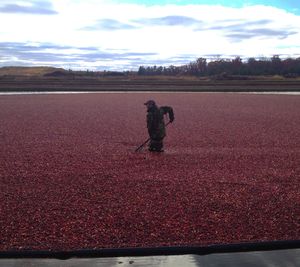Travel: Wisconsin’s Cranberry Harvest is a Sign of the Season
They are one of the first signs of the holiday season: bright red cranberries in a sauce or compote on the Thanksgiving table. Sometimes they’re part of the centerpiece or decorations and they’re there all the way through Christmas.
It used to be that when the holidays were over, the cranberries were gone. But that was then. In the last decade cranberries have moved out of the holiday-only aisle and into the year-round pantries of most Americans. Now they’re baked into cookies and scones, sprinkled on salads and eaten as a quick, healthy, snack.
Most of us grew up with a kind of Norman Rockwell-inspired image of New England as the only place cranberries grow but that isn’t true. Wisconsin has been growing and harvesting the berries for 140 years and since the mid-1970s has produced more cranberries than any other state. Today, more than half the cranberries grown and consumed around the world come from Wisconsin, with Massachusetts, New Jersey, Oregon and Washington trailing.
In the last few years a new industry has grown up around the Wisconsin cranberry harvest: Agritourism. Now you can tour the marshes and get a glimpse of the unique processes involved in growing and harvesting one of the three fruits that are unique to North America (the others two are blueberries and concord grapes.)
I was curious and joined a tour at two Wisconsin cranberry farms: Glacial Lake Cranberries and Elm Lake Cranberry Company.
At Glacial Lake Cranberries we boarded a bus and drove along the narrow pathways between flooded marshes. The iconic image of cranberry fields is a flooded bog filled with floating berries, but they don’t grow that way and the low-growing vines are perfectly acclimated to the sandy soil acidic soil left behind Wisconsin’s ancient glacial lakes. From June through late September they form and ripen. Then, during harvest the marshes are flooded and red-ripe cranberries are scooped off the vines by special tractors (this used to be back-breaking work done by hand) and, thanks to the four small hollow chambers in each berry, float to the top of the water.
Like any kind of farming, growing cranberries is hard work, subject to the whims of nature and the ups and downs of volatile markets. It’s easy to forget the hard work behind the berry when in the fall the cranberries ripen and the beds are flooded to create a temporary marsh.
At Elm Lake Cranberry Company, the rich crimson color of the berries, contrasted against the vivid blue of the sky and the brilliant gold larch trees reflected in the water, was as pretty as a postcard.
With slow, graceful, movements, harvesters dressed in hip-high waders walk the circle of berries corralled by a yellow plastic boom and I watched as a man stretched out his arms, extending the wooden rake in his hands to gather and pull toward him the bright red cranberries while a vacuum swept them up onto a conveyor belt and into the deep bed of a waiting truck.
I know it’s intense and a lot is riding on getting the berries to market without bruising them, but he made it seem like water ballet.
Most of the berries are taken to a nearby processing plant where they will be frozen before being processed into juice, sauce or dried sweetened berries. Only a very small percentage of Wisconsin’s cranberries are packaged fresh for holiday sales.
Like every other behind-the-scenes look I’ve gotten into the heart and soul of any kind of farming--usually thanks to the agritourism movement-- I came away with a deeper appreciation for the small red berry that has always been such a big part of my holiday table. And now, in ever increasing ways, a part of my everyday diet.
Cheryl-Anne Millsap’s audio essays can be heard on Spokane Public Radio and on public radio stations across the U.S. She is the author of “Home Planet: A Life in Four Seasons” and can be reached at catmillsap@gmail.com
